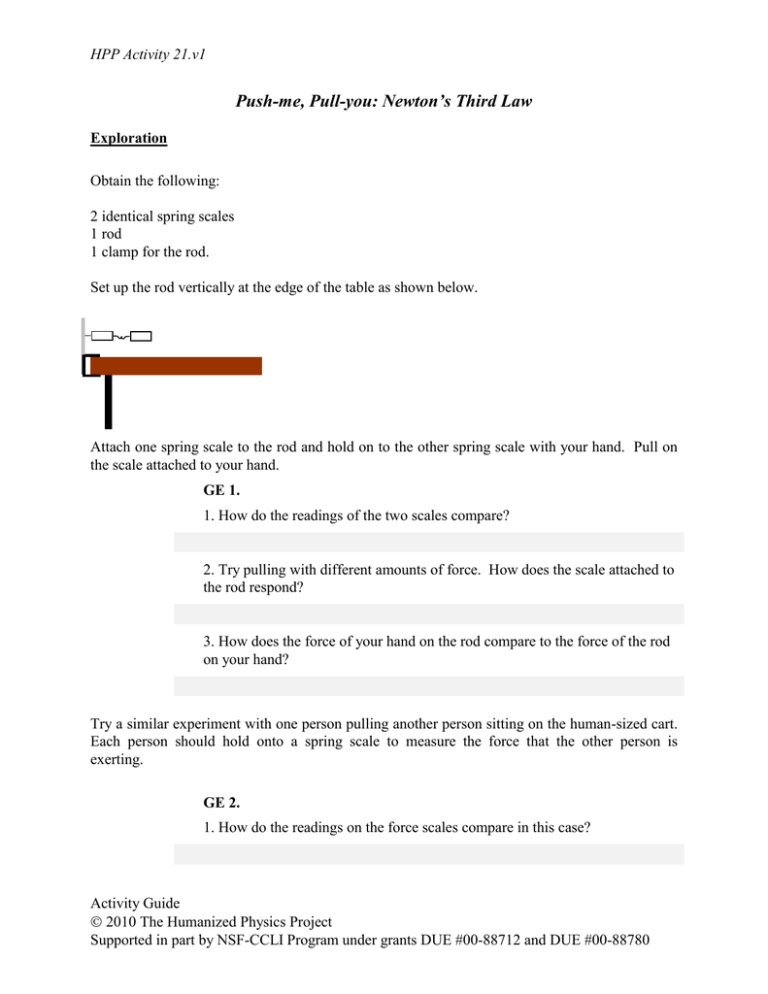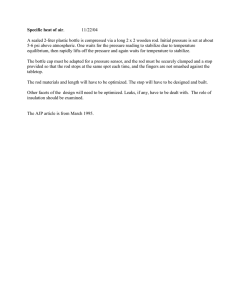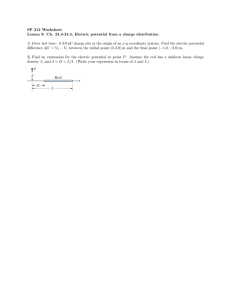Push-me, Pull-you: Newton’s Third Law
advertisement

HPP Activity 21.v1 Push-me, Pull-you: Newton’s Third Law Exploration Obtain the following: 2 identical spring scales 1 rod 1 clamp for the rod. Set up the rod vertically at the edge of the table as shown below. Attach one spring scale to the rod and hold on to the other spring scale with your hand. Pull on the scale attached to your hand. GE 1. 1. How do the readings of the two scales compare? 2. Try pulling with different amounts of force. How does the scale attached to the rod respond? 3. How does the force of your hand on the rod compare to the force of the rod on your hand? Try a similar experiment with one person pulling another person sitting on the human-sized cart. Each person should hold onto a spring scale to measure the force that the other person is exerting. GE 2. 1. How do the readings on the force scales compare in this case? Activity Guide 2010 The Humanized Physics Project Supported in part by NSF-CCLI Program under grants DUE #00-88712 and DUE #00-88780 HPP Activity 21.v1 2. If you are pulling someone on the cart, how does the force you exert on the person-cart compare to the force the person-cart exerts on you? Invention The preceding experiments suggest another law of motion, now known as Newton’s Third Law. This law can be stated as follows. Whenever one object exerts a force on another object, the second object exerts a force back on the first one that is equal in magnitude to the first but opposite in direction to it. This suggests that forces always occur in pairs, sometimes referred to as action-reaction pairs. Sometimes this law is stated as follows. For every action there is a reaction equal in magnitude but opposite in direction. It is important to keep in mind that the action-reaction pair of forces act on different objects. They are not acting on the same object. Application GE 3. Consider the following argument sometimes used to suggest that Newton’s Third Law cannot be correct. Since the reaction force of an action-reaction pair is always directed opposite to the action force, and is equal in magnitude, the two forces must always cancel out, so that an object would never experience an acceleration. Obviously, objects do experience acceleration, so Newton’s Third Law must be wrong. 1. What is the problem with this argument? Compare the magnitudes and directions of the following pairs of forces. Explain your responses. 2. The force of your foot against a football as you kick it, and the force of the ball against your foot. 3. The gravitational force that the earth exerts on the moon, and the gravitational force of the moon on the earth. Activity Guide 2010 The Humanized Physics Project 2




